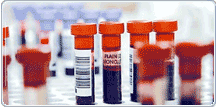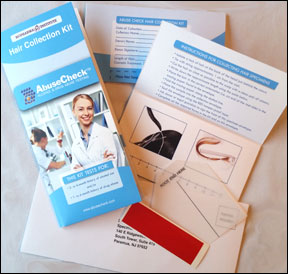CDT Alcohol Abuse Test
 It is now possible to assess people who have been drinking heavily or using alcohol regularly (defined by the World Health Organization as consumption of at least 60 grams of alcohol per day) on a routine basis for a minimum of two weeks. The Carbohydrate Deficient Transferrin (CDT) test, looks at a specific biochemical marker for alcohol consumption.
It is now possible to assess people who have been drinking heavily or using alcohol regularly (defined by the World Health Organization as consumption of at least 60 grams of alcohol per day) on a routine basis for a minimum of two weeks. The Carbohydrate Deficient Transferrin (CDT) test, looks at a specific biochemical marker for alcohol consumption.
CDT levels can be detected for 2-4 weeks after excessive drinking has ceased, providing information about drinking behavior which is too recent to be detected by the AbuseCheck™ FAEE & EtG Hair Alcohol Test.
- Sample Type: Blood
- Sample Amount: 10 cc
- Detection Period: 2-4 weeks.
- Limitation: Not for individuals with congenital glycosylation disorders, chronic hepatitis, cirrhosis, or other liver disorders
Science Behind the CDT Blood Alcohol Test
When alcohol is consumed it is absorbed from the stomach and intestines into the bloodstream and is transported to the liver where the toxins can be processed and removed. The liver is the first organ that all the blood from the stomach and intestines enters before circulating throughout the rest of the body. So, the highest concentration of alcohol will be in the blood flowing through the liver making it more prone to its damaging effects.
The traditional blood alcohol concentration test (BAC) looks for the direct presence of alcohol in the bloodstream. This gives the BAC test a very short window of detection for alcohol abuse (just a few hours). In contrast, the CDT test can indicate excessive alcohol consumption which occurred days, or even 2-4 weeks prior to the sample collection.
CDT Marker
Transferrin is a protein which carries iron through the bloodstream. Under normal conditions, transferrin has 4 carbohydrate groups attached to it. In the presence of excessive alcohol, alternate versions of transferrin can be found with fewer carbohydrate groups (therefore called “carbohydrate-deficient transferrin, CDT). CDT levels become measurable after 2 weeks of excessive alcohol consumption averaging 50g of ethanol per day. CDT levels remain elevated for 2-4 weeks after abstaining from alcohol.
Scientific Methods
A 3 mL sample of serum is required for the test. To obtain enough serum, approximately 10 cc of whole blood must be drawn. The blood is then separated at the collection facility and shipped to the laboratory in a cooler. The CDT blood test uses a widely accepted method of electrophoresis to separate the proteins found in the blood. Since all proteins have unique properties in regards to their size, weight, density, and electrostatic charge, this technique allows technicians to identify the specific proteins present in any sample.
The testing laboratory is CAP (College of American Pathologists) and CLIA (Clinical Laboratory Improvement Amendments) certified.
Who is this test for?
• Employers: Drug testing as part of the pre-employment screening process is becoming more widely accepted. The liability, productivity and health issues surrounding drug abuse in the workplace are important concerns for employers.
• Parents of Teenagers: Parents who want to test their teens to be certain that they are not abusing drugs.
• Rehab centers: Measure the effectiveness of your program.
• For Legal Purposes: Prove your client is fit to have custody of his/her children or for use in post-accident testing.
Benefits
• The CDT blood test compliments the FAEE hair alcohol test by providing alcohol consumption history for the most recent 2-4 weeks, which is not covered by the hair test.
• CDT levels remain elevated for 2-4 weeks after abusive behavior even if an individual has stopped consuming alcohol during that period.
Limitations
• Alcohol Consumption: an individual must consume, on average, 50g of alcohol per day for the duration of at least 2 weeks in order to have a positive CDT test result.
• This test should not be used by individuals with congenital glycosylation disorders, chronic hepatitis, cirrhosis, or other liver disorders.
Process
1. Order your CDT Blood Test
2. Collection materials will be sent to you (for personal testing) or directly to the collection location (for legal testing)
3. Collect the blood sample (either at the collection location, or at your doctor’s office)
4. Send specimens to laboratory.
5. Results will be sent to you (personal testing) or the designated party (legal testing: attorney, social worker, collector, etc) approximately 10 days after the sample is received.


